Input interpretation

Cl_2 (chlorine) + NH_3 (ammonia) ⟶ N_2 (nitrogen) + NH_4Cl (ammonium chloride)
Balanced equation
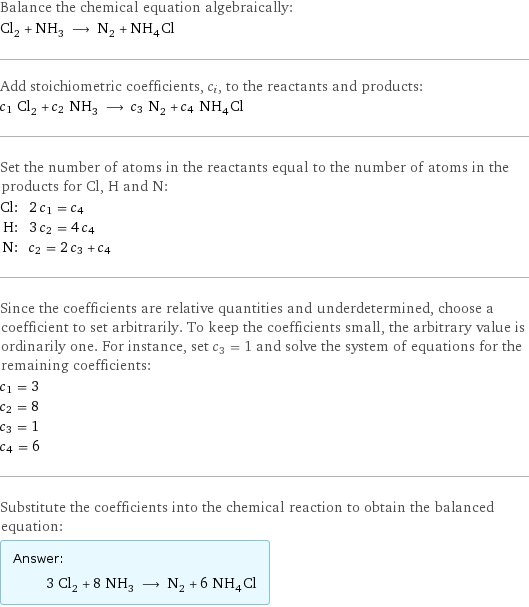
Balance the chemical equation algebraically: Cl_2 + NH_3 ⟶ N_2 + NH_4Cl Add stoichiometric coefficients, c_i, to the reactants and products: c_1 Cl_2 + c_2 NH_3 ⟶ c_3 N_2 + c_4 NH_4Cl Set the number of atoms in the reactants equal to the number of atoms in the products for Cl, H and N: Cl: | 2 c_1 = c_4 H: | 3 c_2 = 4 c_4 N: | c_2 = 2 c_3 + c_4 Since the coefficients are relative quantities and underdetermined, choose a coefficient to set arbitrarily. To keep the coefficients small, the arbitrary value is ordinarily one. For instance, set c_3 = 1 and solve the system of equations for the remaining coefficients: c_1 = 3 c_2 = 8 c_3 = 1 c_4 = 6 Substitute the coefficients into the chemical reaction to obtain the balanced equation: Answer: | | 3 Cl_2 + 8 NH_3 ⟶ N_2 + 6 NH_4Cl
Structures
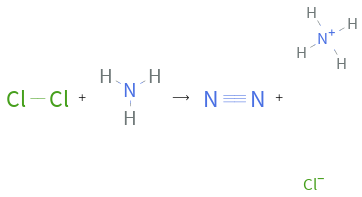
+ ⟶ +
Names

chlorine + ammonia ⟶ nitrogen + ammonium chloride
Reaction thermodynamics
Enthalpy
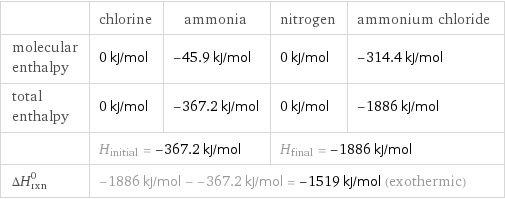
| chlorine | ammonia | nitrogen | ammonium chloride molecular enthalpy | 0 kJ/mol | -45.9 kJ/mol | 0 kJ/mol | -314.4 kJ/mol total enthalpy | 0 kJ/mol | -367.2 kJ/mol | 0 kJ/mol | -1886 kJ/mol | H_initial = -367.2 kJ/mol | | H_final = -1886 kJ/mol | ΔH_rxn^0 | -1886 kJ/mol - -367.2 kJ/mol = -1519 kJ/mol (exothermic) | | |
Gibbs free energy
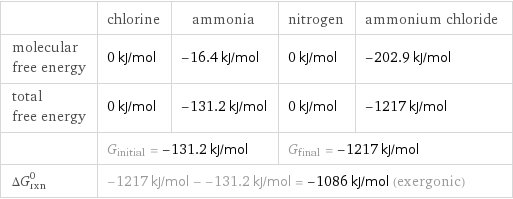
| chlorine | ammonia | nitrogen | ammonium chloride molecular free energy | 0 kJ/mol | -16.4 kJ/mol | 0 kJ/mol | -202.9 kJ/mol total free energy | 0 kJ/mol | -131.2 kJ/mol | 0 kJ/mol | -1217 kJ/mol | G_initial = -131.2 kJ/mol | | G_final = -1217 kJ/mol | ΔG_rxn^0 | -1217 kJ/mol - -131.2 kJ/mol = -1086 kJ/mol (exergonic) | | |
Entropy

| chlorine | ammonia | nitrogen | ammonium chloride molecular entropy | 223 J/(mol K) | 193 J/(mol K) | 192 J/(mol K) | 96 J/(mol K) total entropy | 669 J/(mol K) | 1544 J/(mol K) | 192 J/(mol K) | 576 J/(mol K) | S_initial = 2213 J/(mol K) | | S_final = 768 J/(mol K) | ΔS_rxn^0 | 768 J/(mol K) - 2213 J/(mol K) = -1445 J/(mol K) (exoentropic) | | |
Equilibrium constant
![Construct the equilibrium constant, K, expression for: Cl_2 + NH_3 ⟶ N_2 + NH_4Cl Plan: • Balance the chemical equation. • Determine the stoichiometric numbers. • Assemble the activity expression for each chemical species. • Use the activity expressions to build the equilibrium constant expression. Write the balanced chemical equation: 3 Cl_2 + 8 NH_3 ⟶ N_2 + 6 NH_4Cl Assign stoichiometric numbers, ν_i, using the stoichiometric coefficients, c_i, from the balanced chemical equation in the following manner: ν_i = -c_i for reactants and ν_i = c_i for products: chemical species | c_i | ν_i Cl_2 | 3 | -3 NH_3 | 8 | -8 N_2 | 1 | 1 NH_4Cl | 6 | 6 Assemble the activity expressions accounting for the state of matter and ν_i: chemical species | c_i | ν_i | activity expression Cl_2 | 3 | -3 | ([Cl2])^(-3) NH_3 | 8 | -8 | ([NH3])^(-8) N_2 | 1 | 1 | [N2] NH_4Cl | 6 | 6 | ([NH4Cl])^6 The equilibrium constant symbol in the concentration basis is: K_c Mulitply the activity expressions to arrive at the K_c expression: Answer: | | K_c = ([Cl2])^(-3) ([NH3])^(-8) [N2] ([NH4Cl])^6 = ([N2] ([NH4Cl])^6)/(([Cl2])^3 ([NH3])^8)](../image_source/2739625db5b8d5f41f0012de2c61c142.png)
Construct the equilibrium constant, K, expression for: Cl_2 + NH_3 ⟶ N_2 + NH_4Cl Plan: • Balance the chemical equation. • Determine the stoichiometric numbers. • Assemble the activity expression for each chemical species. • Use the activity expressions to build the equilibrium constant expression. Write the balanced chemical equation: 3 Cl_2 + 8 NH_3 ⟶ N_2 + 6 NH_4Cl Assign stoichiometric numbers, ν_i, using the stoichiometric coefficients, c_i, from the balanced chemical equation in the following manner: ν_i = -c_i for reactants and ν_i = c_i for products: chemical species | c_i | ν_i Cl_2 | 3 | -3 NH_3 | 8 | -8 N_2 | 1 | 1 NH_4Cl | 6 | 6 Assemble the activity expressions accounting for the state of matter and ν_i: chemical species | c_i | ν_i | activity expression Cl_2 | 3 | -3 | ([Cl2])^(-3) NH_3 | 8 | -8 | ([NH3])^(-8) N_2 | 1 | 1 | [N2] NH_4Cl | 6 | 6 | ([NH4Cl])^6 The equilibrium constant symbol in the concentration basis is: K_c Mulitply the activity expressions to arrive at the K_c expression: Answer: | | K_c = ([Cl2])^(-3) ([NH3])^(-8) [N2] ([NH4Cl])^6 = ([N2] ([NH4Cl])^6)/(([Cl2])^3 ([NH3])^8)
Rate of reaction
![Construct the rate of reaction expression for: Cl_2 + NH_3 ⟶ N_2 + NH_4Cl Plan: • Balance the chemical equation. • Determine the stoichiometric numbers. • Assemble the rate term for each chemical species. • Write the rate of reaction expression. Write the balanced chemical equation: 3 Cl_2 + 8 NH_3 ⟶ N_2 + 6 NH_4Cl Assign stoichiometric numbers, ν_i, using the stoichiometric coefficients, c_i, from the balanced chemical equation in the following manner: ν_i = -c_i for reactants and ν_i = c_i for products: chemical species | c_i | ν_i Cl_2 | 3 | -3 NH_3 | 8 | -8 N_2 | 1 | 1 NH_4Cl | 6 | 6 The rate term for each chemical species, B_i, is 1/ν_i(Δ[B_i])/(Δt) where [B_i] is the amount concentration and t is time: chemical species | c_i | ν_i | rate term Cl_2 | 3 | -3 | -1/3 (Δ[Cl2])/(Δt) NH_3 | 8 | -8 | -1/8 (Δ[NH3])/(Δt) N_2 | 1 | 1 | (Δ[N2])/(Δt) NH_4Cl | 6 | 6 | 1/6 (Δ[NH4Cl])/(Δt) (for infinitesimal rate of change, replace Δ with d) Set the rate terms equal to each other to arrive at the rate expression: Answer: | | rate = -1/3 (Δ[Cl2])/(Δt) = -1/8 (Δ[NH3])/(Δt) = (Δ[N2])/(Δt) = 1/6 (Δ[NH4Cl])/(Δt) (assuming constant volume and no accumulation of intermediates or side products)](../image_source/9f9422b2a1a3fb30e560d953b038d4cf.png)
Construct the rate of reaction expression for: Cl_2 + NH_3 ⟶ N_2 + NH_4Cl Plan: • Balance the chemical equation. • Determine the stoichiometric numbers. • Assemble the rate term for each chemical species. • Write the rate of reaction expression. Write the balanced chemical equation: 3 Cl_2 + 8 NH_3 ⟶ N_2 + 6 NH_4Cl Assign stoichiometric numbers, ν_i, using the stoichiometric coefficients, c_i, from the balanced chemical equation in the following manner: ν_i = -c_i for reactants and ν_i = c_i for products: chemical species | c_i | ν_i Cl_2 | 3 | -3 NH_3 | 8 | -8 N_2 | 1 | 1 NH_4Cl | 6 | 6 The rate term for each chemical species, B_i, is 1/ν_i(Δ[B_i])/(Δt) where [B_i] is the amount concentration and t is time: chemical species | c_i | ν_i | rate term Cl_2 | 3 | -3 | -1/3 (Δ[Cl2])/(Δt) NH_3 | 8 | -8 | -1/8 (Δ[NH3])/(Δt) N_2 | 1 | 1 | (Δ[N2])/(Δt) NH_4Cl | 6 | 6 | 1/6 (Δ[NH4Cl])/(Δt) (for infinitesimal rate of change, replace Δ with d) Set the rate terms equal to each other to arrive at the rate expression: Answer: | | rate = -1/3 (Δ[Cl2])/(Δt) = -1/8 (Δ[NH3])/(Δt) = (Δ[N2])/(Δt) = 1/6 (Δ[NH4Cl])/(Δt) (assuming constant volume and no accumulation of intermediates or side products)
Chemical names and formulas
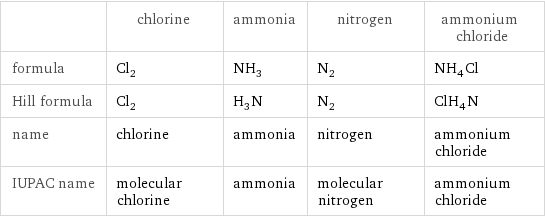
| chlorine | ammonia | nitrogen | ammonium chloride formula | Cl_2 | NH_3 | N_2 | NH_4Cl Hill formula | Cl_2 | H_3N | N_2 | ClH_4N name | chlorine | ammonia | nitrogen | ammonium chloride IUPAC name | molecular chlorine | ammonia | molecular nitrogen | ammonium chloride
Substance properties
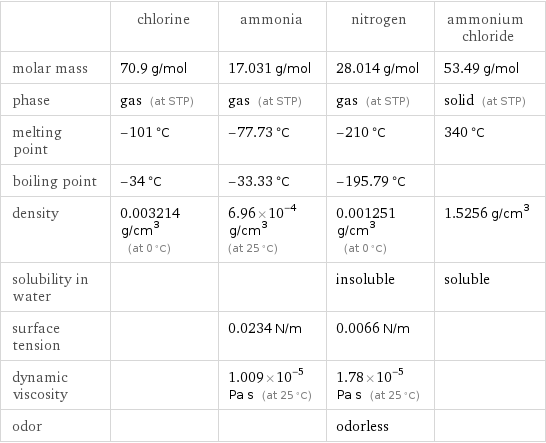
| chlorine | ammonia | nitrogen | ammonium chloride molar mass | 70.9 g/mol | 17.031 g/mol | 28.014 g/mol | 53.49 g/mol phase | gas (at STP) | gas (at STP) | gas (at STP) | solid (at STP) melting point | -101 °C | -77.73 °C | -210 °C | 340 °C boiling point | -34 °C | -33.33 °C | -195.79 °C | density | 0.003214 g/cm^3 (at 0 °C) | 6.96×10^-4 g/cm^3 (at 25 °C) | 0.001251 g/cm^3 (at 0 °C) | 1.5256 g/cm^3 solubility in water | | | insoluble | soluble surface tension | | 0.0234 N/m | 0.0066 N/m | dynamic viscosity | | 1.009×10^-5 Pa s (at 25 °C) | 1.78×10^-5 Pa s (at 25 °C) | odor | | | odorless |
Units
